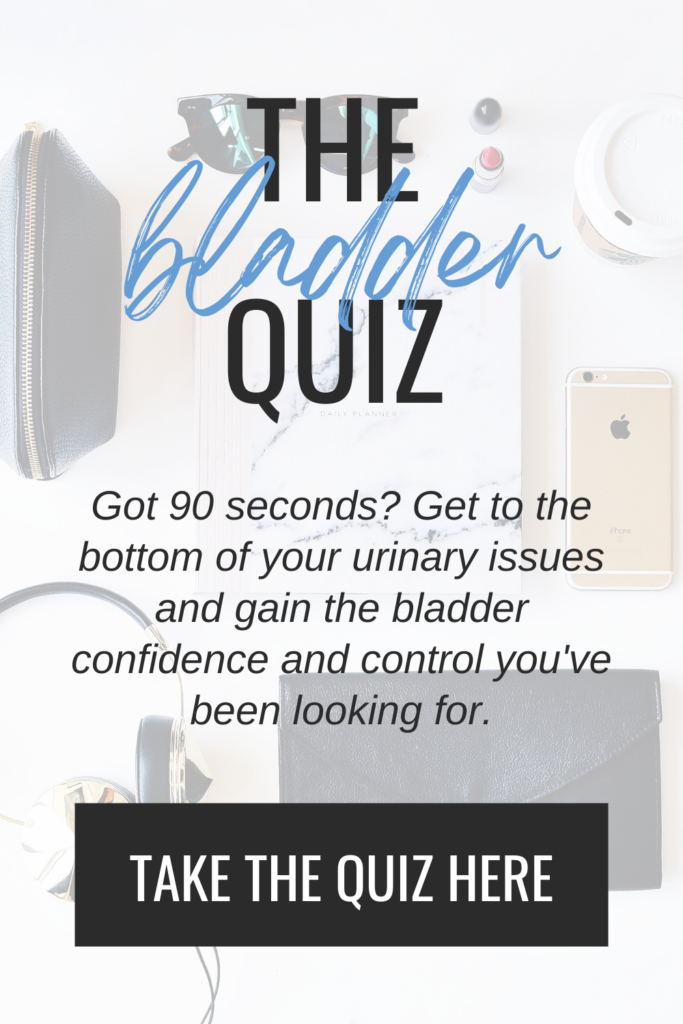“I’m just gonna go to the bathroom real quick!” I yelled, as bacon was cooking burning on the stove top, my toddler was running around diaperless, the dog was begging to come inside, and my husband was suddenly juggling all of the above with coffee cup in hand. My coffee had hit me (you know the feeling), and I was rushing to the toilet…then speeding through my time on the toilet…and while Bob appreciated the hustle, my bladder did not.
RELATED POST: Read [THIS] if Coffee Irritates Your Bladder
Hurrying through urinating can lead to bladder and pelvic health issues if you make this practice a habit. Incomplete emptying, straining to finish, frequency, urgency, leakage, and even UTIs can occur when you don’t take your time in the restroom. And as I share with my patients (and wittily included in the title of this post), it’s called a restroom for a reason and there’s rarely an instance that rushing is ~truly~ necessary.
RELATED POST: 7 Unexpected Causes of a UTI + My Favorite, All-Natural Ways to Prevent + Treat Them
You should be spending at leeeeeeast two minutes in the bathroom from start to finish. And whether that seems crazy long or ridiculously short, try setting a stopwatch the next time you go and see where you land. I’ll tell ya now…the average woman spends significantly less time than this; in fact, if I’m not mindful about my toileting practices, I can be in and out in about 30 seconds flat (she admitted with guilt).
It takes about ten to twenty seconds to pee depending on your fluid intake habits, so you might be wondering how the other minute and a half should be spent. Well…I’m so glad you asked! What you do while in the bathroom can make a world of a difference in your bladder health and control, and just like most tips I share, these shifts take minimal energy and even less time, but the results are undeniable *claps hands*.
PS- These same techniques apply to bowel health too, so if constipation, hemorrhoids, hard poops, or stool frequency and urgency are more of an issue for you, then allow the carryover to commence! I’ll be referring to the bladder in this post, but everything below is same same for the bowels too. If you’re looking for even more poop-related tips click here.
SLOW DOWN
Ok…as I said, it’s called a RESTroom for a reason and you shouldn’t be speeding through your time in the bathroom. Period. Urinating requires a series of reflexes between the bladder, brain, and pelvic floor to occur, and rushing this process can cause a malfunction in the system.
There are multiple ways to set yourself up for success here –
- Be mindful of the language you use around going to the bathroom. Phrases like “real quick”, “will take just a second”, or “I’ll be right back” tell your brain this needs to be a fast endeavor. Instead, a simple “I need to use the restroom” will do, and if anyone prompts you to pick up the pace, I’ll let you get creative with how to respond.
- Shut the door. Kids and/or pets can be the primary culprits behind that need for speed, so keep them out of that space altogether. If you have little ones that can’t be left alone for two minutes, have a high chair or pack n’ play handy specifically for occasions like this.
- Put a clock in the bathroom. When you sit down on the toilet, take a peek at the time and take note. Tell yourself that you have two, whole, glorious, uninterrupted minutes to spend in the bathroom and
forceempower yourself to take them.
Your bladder and pelvic health can and should be a priority, even over a busy work schedule, long to-do list, or screaming babe who prefers not to be put down. Anyone or anything can wait two minutes for you to properly and effectively pee, and that mindset shift starts with you.
NO PHONES
I think we can all agree that phones are grossly over-used sources of distraction, so bringing this diversion in the bathroom where your focus should be 100000000% on your bladder and pelvic floor isn’t the most effective plan. Even if these are your only two minutes of peace and quiet in the day, dare I say that scrolling or staring at a screen don’t exactly promote unwinding.
Because studies show that making a habit is easier than breaking one, I recommend replacing your phone time with something a bit more productive. Beyond the tips below, you can also use this time to reflect on a positive event in your day, say a quick little prayer, recite a mantra, or even do a simple body scan. You’ll be surprised how much this easy adjustment can help with bladder issues, so don’t knock it ‘til ya try it.
RELATED POST: Mantras, Meditation, + 14 Other Kiiiiiinda Crunchy Practices for Stress Relief
DON’T BE “LADY-LIKE“
For some reason, women have been expected to sit differently than men. While baring it all to the world isn’t the best idea, your average gal doesn’t don a dress 24/7 these days, and the crossed legs or pressed-together knees are no longer necessary. In fact, I firmly believe that the “lady-like” way of sitting contributes to the epidemic of pelvic floor tightness and pain, and you better believe I won’t be teaching my daughter to sit this way.
Whew…rant over. Thanks for coming to my Ted Talk.
That said, sitting “properly” while on the toilet causes that same pelvic floor tightness and ultimately makes it difficult for urine to come out. Instead, try channeling your inner tomboy and allow your body to relax – feet flat on the floor, legs spread apart, slouched posture, and hands or elbows rested on your knees. This creates the perfect position for the pelvic floor to fully open and for complete bladder emptying. Bye bye little bit of dribble afterwards or rushing back to the bathroom fifteen seconds later.
BREATHE
I’ve said it once and I’ll say it again 5802391767 times…breathing is one of the easiest to understand, most effective, and readily accessible ways to relax the pelvic floor. I mean, you’re doing it now, right?? When it’s time to pee, the bladder involuntarily contracts to push urine out and the pelvic floor automatically relaxes to create a path for said urine. But if you’re in a rush, on the phone, stressed, or prone to a tight pelvic floor in general, this doesn’t always happen in the order or to the extent that it should.
Taking a few deep piston breaths (deep breathing where the diaphragm, core, and pelvic floor all work and move together) before urinating can help relax the pelvic floor and prepare the urethra to fully open for complete bladder emptying. Focus on the pelvic floor lowering and expanding as you inhale and allow your entire body to relax into the act of breathing.
“LET IT GO”
Beyond piston breathing, there are other ways to relax your pelvic floor in the bathroom to promote healthy and effective urination. Once all distractions are removed, you’re sitting on the toilet properly, and you’ve taken a few piston breaths, the last thing you want to do before starting your stream is a technique I call the “let it go”.
HOW TO “LET IT GO”
1. Perform a mini kegel (or pelvic floor contraction) to tell your brain “these are the muscles I want to relax”.
2. Let the kegel go. Drop, release, open the contraction and let your muscles fall downward. NOTE: This is not pushing…it’s simply relaxing! The muscle excursion isn’t large, so don’t expect a drastic change, but something should feel ~different~.
Beyond the bathroom, there are multiple benefits to knowing how to relax your pelvic floor. Pelvic pain, pain with sex, constipation, period pain, and even low back and hip pain can all improve by practicing this technique, and it’s a tool all women should have in their back pocket. Grab this free guide on my four favorite steps to relaxing the pelvic floor (with even more guidance on the “let it go” included) and take the best first step to pelvic and bladder health.
RELATED POST: My Daily Pelvic Floor Relaxation Routine + Why You Might Want to Try It Too
DON’T STOP YOUR STREAM
Sooooooo you know those reflexes that automatically cause the bladder to contract and pelvic floor to relax for urination? Stopping your urine stream to test your muscle control, work on your pelvic floor strength, or because someone on social told you to can disrupt those natural reflexes and create a rippling effect of bladder and pelvic floor dysfunction. In other words…please never stop your urine mid-stream.
Relaxing the pelvic floor should 100000000% be your main focus on the toilet, and nothing more. If kegels and pelvic floor strengthening are your current goal, that’s great! Just make sure you’re doing them outside of your precious two minutes in the bathroom.
“I thought of you while peeing today” is a statement I hear on the regular and a sentiment I #noshame consider quite the compliment. And truth be told, I kiiiiiiinda hope that after reading this post, you think of me while on the toilet too *wink wink*. Easy, accessible, and actionable are my MO when it comes to pelvic health, and full bladder control is in your future if you’re open to making little tweaks like [this].
Now if you like this info, I’ve gotta be honest with ya…you’ll ~love~ my online course, The Bladder Blueprint, an A-Z roadmap to less leakage, urgency, and frequency in a fool-proof, step-by-step format to ensure a hands over heart success. The tips above are bound to bring results, but something magical happens (aka – lifelong resolution of annoying bladder issues) when you’ve got the whole process laid out for you.
One in three women have bladder problems, but I’m on a mission to flip that statistic and truly believe it can be done with why-has-no-one-told-me-this-before education, simple habit shifts, and bit of mindfulness. Practice this advice, teach it to your daughters, share it with your friends, heck…even mention it to the gal in the stall next to you! You deserve confidence in and control over your bladder, and the steps above are a great place to start.
-Amanda
Disclaimer: The content provided here does not constitute medical advice, nor is it a substitute for personalized healthcare. I’m a doctor, but I’m not your doctor. If you have concerns about a medical condition, diagnosis, or treatment, you should consult with a licensed healthcare professional.
Disclosure: Some of the links above are affiliate links, meaning, at no additional cost to you, I will earn a commission if you click through and make a purchase. No pressure, but I have a feeling you’re gonna like what I’ve taken the time to put my recommendation behind.



















